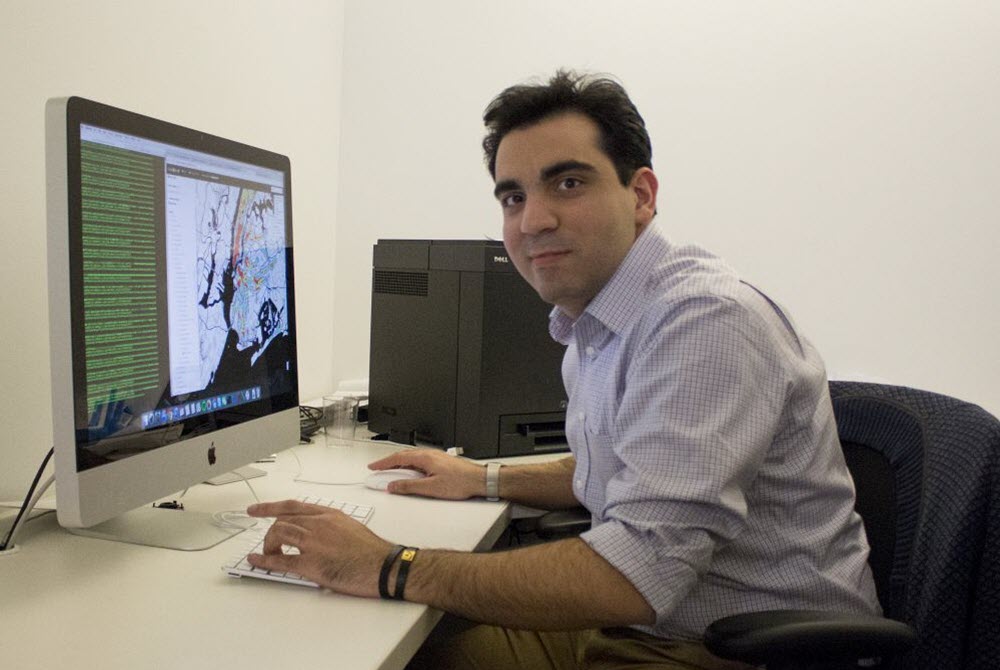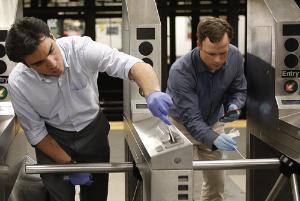Medical Student Ebrahim Afshinnekoo Part of Project to Test NYC Subways for COVID-19
Rising fourth-year medical student Ebrahim Afshinnekoo’s passion for research has long been in evidence.

So it came as no surprise that when the COVID-19 pandemic hit New York, Mr. Afshinnekoo rose to the occasion as part of a team to test New York City (NYC) hospitals and urban environments for the prevalence of severe acute respiratory syndrome coronavirus 2 (SARS-CoV-2) and other viruses and to address the limitations in patient testing.
“It was an ‘all hands on deck’ situation in the lab, and I jumped at the opportunity to do my part,” says Mr. Afshinnekoo. “With clinical rotations suspended, I wasn't able to help support our healthcare workers on the front lines, but I was able to help fight the pandemic through this research.”
It was during his undergraduate years at Macaulay Honors College at Queens College that Mr. Afshinnekoo first began working with Christopher Mason, Ph.D., associate professor at Weill Cornell Medicine, on a project to collect DNA from the NYC subway system to study the urban microbiome and create a molecular portrait of New York City. That project later led him and Dr. Mason, in 2015, to co-found the MetaSUB (metagenomics of subways and urban biomes) International Consortium. Mr. Afshinnekoo currently serves as clinical director for MetaSUB.
“An event such as the COVID-19 pandemic was one of the reasons we founded the consortium, so that we could utilize next-generation sequencing technology to catalog and characterize urban microbiomes and aid public health officials and clinicians with surveillance and tracing,” says Mr. Afshinnekoo. “So when COVID-19 hit, we galvanized our resources to collect samples and try to adjust our protocols (which had been DNA-based sampling and analysis) to include RNA in order to detect SARS-CoV-2.”
For the project, the group designed and optimized a rapid LAMP (loop-mediated isothermal amplification) assay to detect SARS-CoV-2 infection from nasopharyngeal swab specimens and oropharyngeal swab lysates, as well as a large-scale RNA sequencing platform for host and viral profiling. Both technologies were then applied to specimens from 735 confirmed or suspected COVID-19 patients at New York-Presbyterian Hospital-Weill Cornell Medical Center (NYPH-WCMC) and 86 environmental samples collected from high-transit areas in the NYC subway in early March 2020.
 |
Throughout the project, Mr. Afshinnekoo served as a clinical research associate, putting together and managing the Institutional Review Board (IRB) approvals and protocols for the study, as well as working on the study design, analysis and clinical interpretation of our results.
In addition to validating their new diagnostic assay, the group found that the “SARS-CoV-2 evolution maps revealed the likely origin of NYC infections as being from Europe, and less commonly from Asia, plus we found evidence of a NYC-specific clade and some novel mutations,” explains Mr. Afshinnekoo.
As research on the spread of COVID-19 has focused on its persistence on a range of surfaces, a key question in heavily populated areas like NYC was whether fomite transmission in high-traffic areas, such as subways, may have driven its rapid spread. “Our environmental sampling of some high traffic NYC subway station areas have revealed no SARS-CoV-2 on subway surfaces at the dawn of the NYC pandemic in mid-March.”
In addition, the retrospective observational cohort analysis of thousands of COVID-19 patients at NYPH-Columbia University Irving Medical Center found that patients with hypertension who take angiotensin-converting enzyme inhibitors and angiotensin II receptor blockers had higher infection rates than patients with hypertension on calcium channel blockers, but no significant risk for intubation or mortality.
The group is now working on sequencing and analyzing more samples. “While the LAMP diagnostic assay has been validated on nasopharyngeal and oropharyngeal swabs, with the latest studies coming out with saliva being more sensitive for detecting SARS-CoV-2, we would like to validate it on saliva specimens as well,” says Mr. Afshinnekoo.
While the study reported preliminary results of the environmental sampling in NYC, throughout the pandemic, MetaSUB’s global network of scientists have been collecting environmental samples from subways, hospitals, and city centers in over 50 cities. The next phase of the study will involve sequencing and analyzing environmental samples across the consortium.
Mr. Afshinnekoo is also establishing a collaboration to run the LAMP assay at New York Medical College with samples collected from the Family Health Center and hopefully Westchester Medical Center. “I would also like to expand our electronic health record analysis to other medical centers, especially the communities and hotspots that have been hit worst by the pandemic,” says Mr. Afshinnekoo. “Hopefully these areas and data can shed valuable insights on the pathophysiology and complications of COVID-19.”
With plans to pursue a residency in ophthalmology, he is also interested in researching more about the ocular manifestations (e.g., conjunctivitis, blurry vision) that have been reported with COVID-19.
“The LAMP assay we developed, which is currently awaiting FDA approval before it can be fully deployed, is cheap, fast, and scalable, with the potential to rapidly expand testing capacity throughout New York and the nation at large.” he says. “Thankfully, New York has been flattening the curve, however access to testing is still limited and will be critical as we begin to open up the state and return to work. Moreover, as we recover from the pandemic and look ahead to potential resurgences as we re-open or during the upcoming flu season, it will be critical to have a robust testing platform.”
